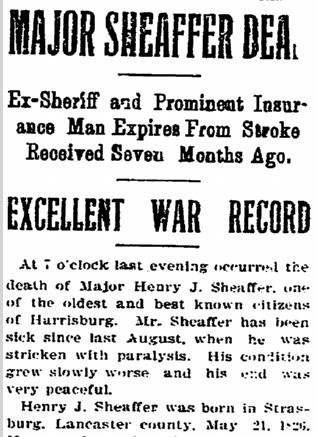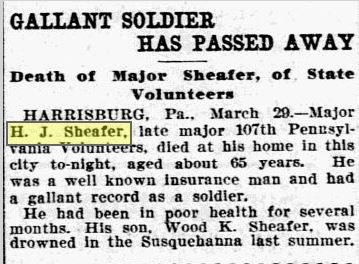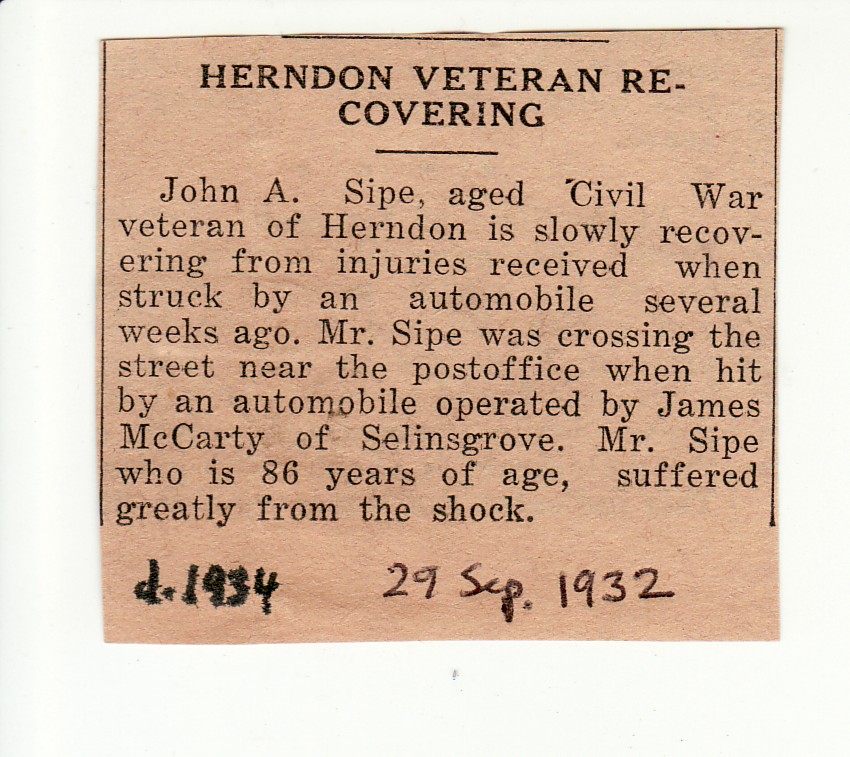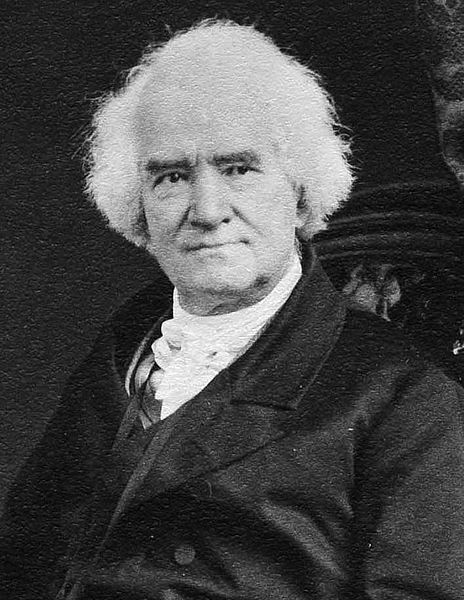Death of Major H. J. Sheafer, Ex-Sheriff of Dauphin County
Posted By Norman Gasbarro on January 4, 2014
The death of Major Henry Jackson Sheafer (also known as Sheaffer) was reported in the 30 March 1900 edition of the Harrisburg Patriot:
MAJOR SHEAFFER DEAD
Ex-Sheriff and Prominent Insurance Man Expires from Stroke Received Seven Months Ago
EXCELLENT WAR RECORD
A 7 o’clock last evening occurred the death of Major Henry J. Sheaffer, one of the oldest known citizens of Harrisburg. Mr. Sheaffer has been sick since last August, when he was stricken with paralysis. His condition grew slowly worse and his end was very peaceful.
Henry J. Sheaffer was born in Strasburg, Lancaster County, 21 May 1826. He was educated in the schools of that vicinity and early in his life removed to this city. He was a major of the 107th Regiment of Pennsylvania Volunteers [107th Pennsylvania Infantry] and served with distinction during the rebellion. He was a prominent figure in the Grand Army of the Republic for many years and was honored as a member of the Loyal Legion.
At one time Mr. Sheaffer was prominent in politics of the county and served one term as sheriff. Of late years he he has been in the insurance business and was one of the best known men in this business in the city. He has associated with him in this business his son, the late Select Councilman Wood K. Sheaffer.
Mr. Sheaffer resided for a long time at Second and State Streets and there his death occurred. He is survived by one son, Alpheus H. Sheaffer of Harrisburg, and three daughters, Mrs. W. C. Phouts and Mrs. John A. Westbrook of this city, and Mrs. George W. Mindill of New York City.
The funeral will be held on Monday afternoon with services at the house. They will be conducted by Rev. J. Ritchie Smith, pastor of the Market Square Presbyterian Church, and will be attended by Post 58, Grand Army of the Republic, as well as the many relatives and friends of the deceased. The pallbearers were all selected by Mr. Sheaffer before his death, and will be Captain John C. Delaney, Thomas McCamant, Major Foster, Gilbert M. McCauley, Samuel Fleming and Major Lane S. Hart.
Some of the things not mentioned in the obituary include the following:
1. In 1850, Henry Jackson Sheafer and his wife ran a large hotel in Wiconisco Township. That fact is noted on the census return for that year:
2. In 1860, Henry was in Mendota, Dakota County, Minnesota, where he was working as a miller. The youngest child listed, Wood Sheafer, was born in Minnesota:
3. However, the Commemorative Biographical Encyclopedia of Dauphin County gives a slightly different version of his arrival in Minnesota and occupations in both Wiconisco Township and Minnesota – and adds side trips and residencies in Columbia, South Carolina, and Milton, Northumberland County, Pennsylvania :
Major Henry Jackson Sheafer, son of Michael Sheafer and Susan Cloud, was born 21 May 1826, in Lancaster County, Pennsylvania. When about six years of age his father removed to what was then called Bear Gap, now Wiconisco, in the upper end of Dauphin County. Here he resided with his parents getting a few months schooling during the winter season until the age of fifteen, when he went to learn the drug business at Harrisburg. He continued in this employment for four years, when he went to South Carolina and resided for some time in Columbia, the capital. Coming north, he settled in the town of Milton, Northumberland County and engaged in the drug trade….At the death of his father he removed to the old home at Wiconisco, for the purpose of settling his father’s estate.
In 1856 he removed to Mendota, Dakota County, Minnesota, where he engaged in the lumber business in connection with Eli Pettijohn and Franlin Steele of Fort Snelling. They built a large mill at the mouth of the Minnesota River. In the fall of 1858 he was elected a member of the Minnesota Legislature from Dakota County, and for some time took an active part in the politics of the young state. After the breaking out of the war all business was completely paralyzed and in the fall of 1863 he returned to Harrisburg.
4. The war record of Henry Jackson Sheafer begins with him recruiting a company for the 107th Pennsylvania Infantry:
The first card (above) from the Pennsylvania Archives notes that he enrolled at Harrisburg on 27 December 1861 and was mustered in as Captain of Company I, 107th Pennsylvania Infantry, on 8 March 1862, also at Harrisburg. At the time he was 36 years old and gave his occupation as lumber merchant. He was promoted to Major on 23 February 1863, and transferred to Headquarters.
The second card (above) from the Pennsylvania Archives has more detail – indicating he was discharged on 8 March 1865 and afterward received a promotion to Brevet Major and Colonel on 13 March 1865. Also on this card is the fact that he was wounded at Gettysburg on 1 July 1863. Below is the portion of the plaque to the 107th Pennsylvania Infantry on the Pennsylvania Memorial at Gettysburg – showing “H. J. Sheaffer” as Major.
5. But the Commemorative Biographical Encyclopedia of Dauphin County gives more detail about his war record:
During the winter of 1861-1862 he recruited a company for the One Hundred and Seventh Regiment, Pennsylvania Volunteers, and was mustered into the service as captain of Company I. At the Battle of Antietam his brigade fought in the noted cornfield almost fronting the Dunker Church, and suffered terribly in killed and wounded. at one time the line being driven back both color-bearers were shot dead and left on the field. Captain Sheafer, ascertaining the fact, returned alone and rescued the colors and rejoined his command without injury. On 21 December 1862, he was commissioned Major of the regiment. In the Gettysburg Campaign, on the first day of the fight, shortly after Reynolds was killed, Major Sheafer was severely wounded, but did not leave the field until the afternoon of the third day’s fight. Early in the fall he rejoined his command and participated with his regiment in the many battles they were engaged in up to 8 march 1865 (the expiration of his term of service) and was mustered out….
6. After the war, he decided to make his permanent residence in Harrisburg and it was there he entered the insurance business. Major Shaefer’s term of service as Sheriff of Dauphin County was from 1873-1876. During that time, his name appeared on all legal ads published in the Harrisburg Patriot that pertained to the duties of the Sheriff.
7. Finally, the mention in the Patriot obituary of the “late” Select Councilman Wood K. Sheaffer needs to be clarified.
The last sentence in the obituary of Major Sheafer which appeared in the Philadelphia Inquirer (above), partially clears up the mystery: “His son, Wood K. Sheafer, was drowned in the Susquehanna last summer.” Wood K. Sheafer‘s death notice was published in the Harrisburg Patriot on 26 July 1898 – with no mention of how he died.
No other articles or notices have been located which explain how he died.
——————————
News clippings are from the on-line resources of the Free Library of Philadelphia. Additional information is sought on Major Henry Jackson Sheafer – including pictures and stories. Reader input is welcome.
 ;
;














